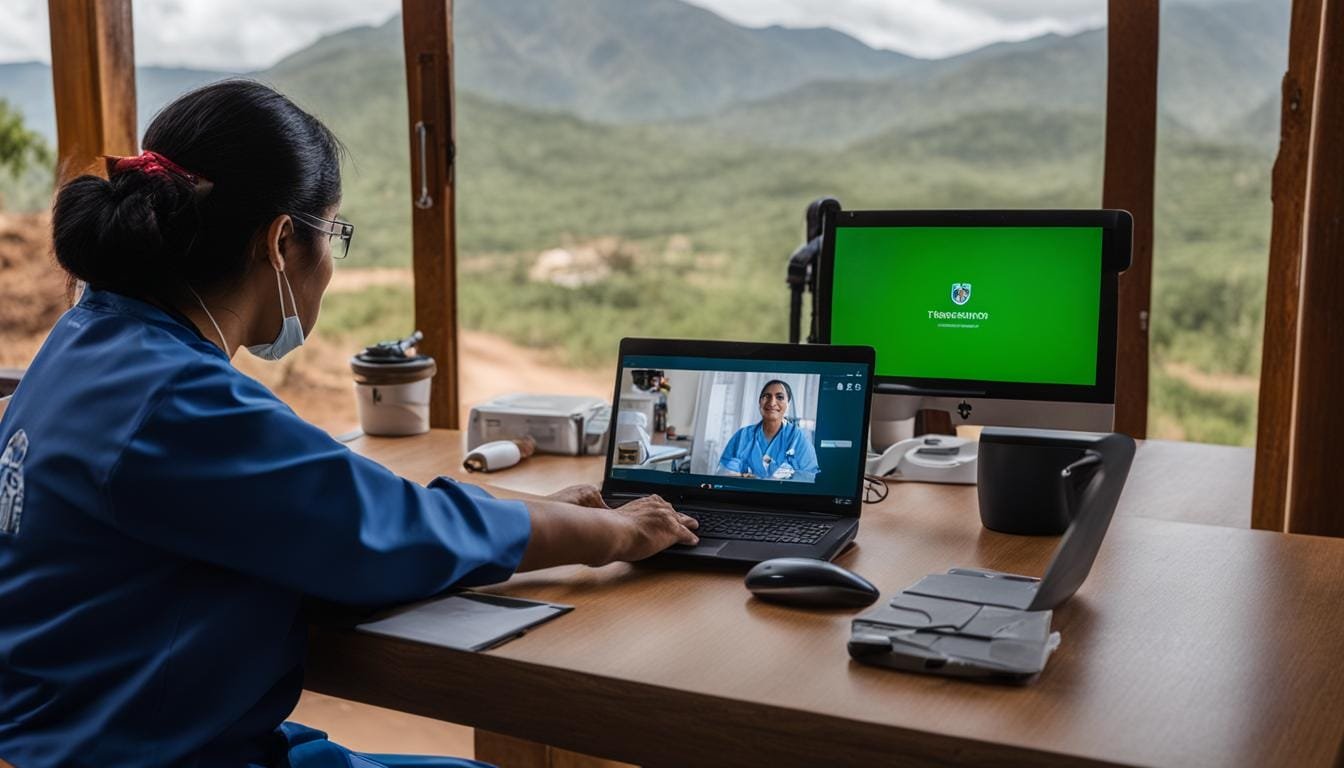Telehealth in Mexico is revolutionizing the way healthcare is delivered, providing virtual healthcare services and online medical consultations to bridge the gap in healthcare access. With the advancement of telemedicine technology, patients can now receive remote healthcare services, allowing them to connect with healthcare providers from the comfort of their homes.
Telehealth technology has transformed the healthcare landscape in Mexico by offering digital health services, expanding healthcare access, and improving patient outcomes. Through telehealth, digital doctor appointments have become a convenient and efficient way for patients to receive the care they need.
Key Takeaways:
- Telehealth in Mexico provides virtual healthcare services to improve healthcare access.
- Online medical consultations allow patients to connect with healthcare providers remotely.
- Telehealth technology offers convenient digital doctor appointments for patients.
- Remote healthcare services improve patient outcomes and reduce healthcare disparities.
- Telehealth is a promising solution for expanding healthcare access in Mexico.
The Impact of Telehealth in Mexico
Telehealth in Mexico has had a significant impact on healthcare access and cost savings. It has helped reduce the healthcare access gap, particularly in rural and underserved areas where access to medical facilities is limited.
One of the key benefits of telehealth is the provision of virtual consultations, which eliminates the need for travel and reduces wait times. Patients can now connect with healthcare providers remotely, saving time and avoiding the challenges associated with accessing in-person appointments.
By embracing telehealth, Mexico has been able to reduce healthcare costs in several ways. Firstly, it prevents unnecessary hospital admissions and readmissions by providing early intervention and remote monitoring for chronic diseases. This proactive approach not only improves patient outcomes but also reduces the financial burden on the healthcare system.
Telehealth also plays a crucial role in expanding access to specialized care. Patients from remote locations can now access the expertise of doctors and specialists, even if they are located in different parts of the country or even abroad. This reduces the strain on hospitals and clinics, allowing them to focus on critical cases and ensuring better overall healthcare delivery.
Overall, telehealth solutions are revolutionizing healthcare in Mexico. By leveraging technology, healthcare providers are bridging the gap in healthcare access, improving patient outcomes, and reducing costs.
The Evolution of Telehealth in Mexico
Telehealth has become an integral part of addressing healthcare challenges in Mexico, providing innovative solutions to improve access and affordability. One significant development is the ability for doctors and specialists to conduct remote consultations, reducing the need for patients to physically visit healthcare facilities. This has not only improved accessibility but also resulted in reduced wait times for patients.
Furthermore, the evolution of telehealth in Mexico has introduced cost-saving benefits for patients. By eliminating the need for transportation and time off work, telehealth eliminates potential financial burdens for individuals seeking medical care. The convenience of online platforms enables patients to connect with healthcare providers conveniently and receive quality care from the comfort of their homes.
The impact of telehealth on cost savings is significant. The table below illustrates the potential cost savings in comparison to traditional in-person consultations:
| Cost | In-person Consultation | Telehealth Consultation | Cost Savings |
|---|---|---|---|
| Transportation | $50 | $0 | $50 |
| Missed Work Days | $100 | $0 | $100 |
| Total Cost | $150 | $0 | $150 |
The cost savings demonstrated in the table highlight the financial advantages of telehealth for patients. By reducing transportation and missed work days expenses, telehealth consultations offer a more affordable option for individuals seeking healthcare services.
In conclusion, the evolution of telehealth in Mexico has brought about significant changes in the healthcare landscape. Through remote consultations and online platforms, telehealth addresses the challenges of limited access to medical services and provides cost-effective options for patients. As the telehealth industry continues to grow, it has the potential to revolutionize healthcare delivery and improve overall healthcare outcomes.
Breaking Down Barriers to Healthcare Access with Telehealth
Telehealth is revolutionizing healthcare access in Mexico, particularly in rural and underserved areas. It has become a powerful tool in overcoming long-standing barriers to healthcare, providing convenient and accessible healthcare options for individuals who have limited access to medical facilities.
One of the key ways telehealth is breaking down barriers is through virtual consultations. Patients can now connect with doctors and specialists remotely, eliminating the need for long-distance travel or waiting for appointments. Through video conferencing technology, individuals in rural areas can receive the care they need without the challenges of geographical distance.
Additionally, telehealth enables remote diagnosis and monitoring through the use of digital equipment. Patients can share test results and medical data online, allowing healthcare professionals to review and provide recommendations without the need for in-person consultations. This is particularly beneficial for individuals residing in remote areas where access to advanced medical equipment may be limited.
The adoption of telehealth technology is bridging the gap in healthcare access by leveraging digital solutions to connect patients with healthcare providers. Through virtual consultations and digital equipment, telehealth is improving access to quality care, even in the most challenging circumstances.
Telehealth and the Role of Government Regulations
Government regulations play a crucial role in the implementation and operation of telehealth in Mexico. These regulations ensure patient safety, privacy rights, and quality care standards. They also address licensing requirements for healthcare providers and reimbursement policies to support sustainable telemedicine programs.
The General Health Law was amended to include provisions for telemedicine, allowing health professionals to prescribe outside health facilities using electronic means. This amendment has been instrumental in expanding access to healthcare services, especially in remote areas where access to medical facilities is limited.
Regulatory institutions like COFEPRIS (Federal Commission for Protection against Sanitary Risk) oversee the adoption of telehealth technologies and ensure compliance with data transmission security and informed consent procedures. They play an important role in safeguarding patient information and ensuring that healthcare providers adhere to ethical standards.
By enforcing government regulations, Mexico aims to create a secure and reliable telehealth infrastructure that protects patient privacy while providing convenient access to healthcare services.
Patient Safety and Privacy Rights
Government regulations in Mexico prioritize patient safety and privacy rights when it comes to telehealth. These regulations establish guidelines for secure data transmission, ensuring that patient information is protected from unauthorized access or misuse. Telehealth platforms and service providers must adhere to strict data protection protocols, including encryption and secure storage practices.
Additionally, privacy rights are safeguarded to ensure that patients’ personal health information remains confidential. Telehealth providers are obligated to obtain informed consent from patients before sharing any health-related data, reinforcing patient autonomy and control over their private information.
Licensing Requirements and Quality Care Standards
Government regulations also address licensing requirements for healthcare providers practicing telehealth in Mexico. These requirements ensure that healthcare professionals possess the necessary qualifications and expertise to deliver medical services remotely. By enforcing licensing standards, the government aims to maintain the quality of care provided through telehealth and protect patients from unqualified practitioners.
Furthermore, government regulations outline quality care standards that telehealth providers must meet. These standards encompass best practices, protocols, and guidelines for delivering healthcare services remotely. By adhering to these standards, telehealth providers can ensure that their services are safe, effective, and aligned with established medical protocols.
Reimbursement Policies for Telemedicine Programs
Another important aspect of government regulations in Mexico is the establishment of reimbursement policies for telemedicine programs. These policies determine the financial framework for healthcare providers offering telehealth services. By implementing reimbursement policies, the government incentivizes the adoption of telemedicine and supports its long-term sustainability.
Reimbursement policies not only encourage healthcare providers to offer telehealth services but also ensure that patients have adequate access to affordable care. The availability of reimbursement for telehealth consultations reduces financial barriers and makes healthcare services more accessible to a broader population.
Overall, government regulations in Mexico play a pivotal role in shaping the telehealth landscape. By prioritizing patient safety, privacy rights, licensing requirements, and reimbursement policies, these regulations create a framework that fosters the growth and effectiveness of telemedicine in the country.
Learn more about the impact of government regulations on telehealth in Mexico in the following table:
| Government Regulations | Impact on Telehealth in Mexico |
|---|---|
| Ensures patient safety and privacy rights | Protects confidential information and secures data transmission |
| Defines licensing requirements for healthcare providers | Ensures qualified practitioners deliver telehealth services |
| Establishes quality care standards | Promotes safe and effective healthcare services through telemedicine |
| Implements reimbursement policies | Supports financial sustainability and accessibility of telehealth |
To fully reap the benefits of telehealth, it is essential to have robust government regulations that protect patient rights, ensure high-quality care, and facilitate sustainable telemedicine programs. By striking a balance between innovation and regulation, Mexico can continue to expand access to healthcare services through telehealth while maintaining patient safety and privacy.
Telehealth in Rural and Underserved Areas
Telehealth is revolutionizing healthcare access in rural and underserved areas of Mexico. By overcoming geographical and logistical constraints, telehealth brings healthcare services closer to those who need them most. Through the power of virtual consultations, patients in remote areas can now receive specialized care from healthcare providers located elsewhere in the country or even abroad.
Imagine a patient living in a small village nestled in the mountains, hours away from the nearest medical facility. Traditionally, accessing healthcare services would mean enduring long journeys, costly travel expenses, and significant time commitments. However, with telehealth, this patient can now connect with a doctor through virtual consultations without leaving their own home.
Geographical barriers are no longer a hindrance to quality healthcare. Telehealth transcends distances and brings medical expertise directly to the patient’s doorstep. Whether it’s a routine check-up, chronic disease management, or even mental health support, telehealth ensures that patients in rural and underserved areas have the same opportunities for care as their urban counterparts.
“Telehealth has transformed the way we reach and treat patients in remote areas. It has allowed us to bridge the gap and ensure that everyone, regardless of their location, can access the care they need.”
– Dr. Maria Sanchez, Telehealth Specialist
Moreover, telehealth significantly reduces the burden on hospitals and clinics by lowering patient volumes. With virtual consultations, patients can have their healthcare needs addressed promptly, without adding strain to already stretched healthcare facilities. This increased efficiency enables healthcare providers to focus on delivering quality care to a larger number of patients.
While telehealth has its challenges, such as limited access to technology and infrastructure limitations, its potential for overcoming geographical and logistical constraints cannot be denied. The continuous development of telehealth technology and infrastructure improvements will only further enhance healthcare access in rural and underserved areas.
Telehealth is not just a tool; it is a lifeline for millions of people who previously struggled to access quality healthcare. By breaking down barriers and empowering patients with convenience and choice, telehealth is transforming healthcare in Mexico, one virtual consultation at a time.
| Benefits of Telehealth in Rural and Underserved Areas | Examples |
|---|---|
| Improved healthcare access | A patient from a remote village can connect with a specialist in a distant city without leaving their home. |
| Reduced travel expenses and time commitment | Avoiding long journeys and costly travel expenses by receiving virtual consultations from the comfort of their own environment. |
| Lowered patient volumes in hospitals and clinics | Patients can receive prompt healthcare services through virtual consultations, reducing the strain on healthcare facilities. |
| Access to specialized care | Patients can easily connect with healthcare providers who specialize in their specific medical needs, regardless of their location. |
| Increased efficiency in healthcare delivery | Healthcare providers can reach and treat a larger number of patients, optimizing resources and improving overall patient outcomes. |
The Benefits of Telehealth for Patients and Providers
Telehealth offers numerous benefits for both patients and healthcare providers in Mexico. Patients can receive convenient healthcare services from the comfort of their homes, saving time and money on transportation. Telehealth also provides cost savings by reducing administrative overheads and allowing providers to treat more patients without increasing resources. It improves access to quality care by enabling virtual consultations and real-time information sharing between patients and providers.
For patients, telehealth eliminates the need to travel to a healthcare facility, especially for routine follow-ups and minor health concerns. This not only saves time but also reduces transportation costs, making healthcare more accessible and affordable. Telehealth provides the convenience of scheduling appointments according to one’s availability, eliminating long waiting times and overcrowded waiting rooms. Patients can have virtual consultations with healthcare professionals in the comfort and privacy of their own homes.
In addition to convenience, telehealth offers a range of patient benefits. Remote healthcare services allow patients to access timely medical advice and prescriptions without a physical visit to a doctor’s office. This is particularly beneficial for individuals with chronic conditions who require regular monitoring and medication adjustments. Telehealth enables seamless communication between patients and healthcare providers, promoting better adherence to treatment plans and overall health management.
Telehealth enables seamless communication between patients and healthcare providers, promoting better adherence to treatment plans and overall health management.
Healthcare providers also experience various benefits with the integration of telehealth into their practice. Telehealth eliminates geographical barriers, allowing providers to reach patients in remote areas or regions with limited access to specialized healthcare. By adopting telehealth technology, healthcare providers can expand their services without incurring additional facility costs. This enables providers to see more patients and optimize their resources efficiently.
Furthermore, telehealth reduces administrative burdens and streamlines workflows for healthcare providers. Virtual consultations and electronic health records minimize paperwork and improve efficiency, enabling providers to spend more time with patients and focus on delivering quality care. Telehealth also fosters collaboration among healthcare professionals, facilitating easy access to second opinions, remote consultations, and knowledge sharing.
Benefits of Telehealth for Patients and Providers
| Benefits for Patients | Benefits for Providers |
|---|---|
|
|
The Impact of Telehealth on Healthcare Costs
Telehealth has revolutionized healthcare costs in Mexico, offering a cost-effective solution for patients and the healthcare system. By leveraging telemedicine technology, remote consultations have become feasible, eliminating the need for unnecessary hospital admissions and reducing overall healthcare expenses.
One of the key areas where telehealth has made a significant impact is in chronic disease management. Patients with chronic conditions require regular monitoring and ongoing care, which can be expensive and time-consuming. Telehealth enables remote management of chronic diseases, allowing patients to have virtual consultations with their healthcare providers from the comfort of their homes.
“Telehealth has reduced my healthcare costs significantly. Instead of frequent visits to the hospital, I can now have virtual appointments with my doctor. It not only saves me time and money but also ensures I receive the care I need.”
Additionally, telehealth provides an opportunity for healthcare providers to optimize resources and deliver high-quality care more efficiently. By leveraging telemedicine technology, healthcare professionals can remotely monitor patients, offer timely interventions, and provide personalized care. This technology allows providers to reach a larger patient population without increasing their physical resources.
Overall, the implementation of telehealth has resulted in significant cost savings for both patients and healthcare systems in Mexico. By reducing unnecessary hospital visits, optimizing resources, and improving chronic disease management, telehealth offers a cost-effective approach to healthcare delivery.
Through the use of telehealth, Mexico is witnessing a transformation in healthcare costs, making quality care more accessible and affordable for all.
Overcoming Obstacles in Telehealth Adoption
The adoption of telehealth in Mexico faces several obstacles. Limited access to technology, particularly in rural and low-income areas, poses challenges for telemedicine consultations. Without adequate access to smartphones, computers, or stable internet connections, individuals in these areas may struggle to engage in virtual healthcare services. It is essential to bridge this digital divide to ensure equitable access to telehealth across Mexico.
Legal and regulatory issues also hinder the widespread adoption of telehealth. Licensing requirements and reimbursement policies must be addressed to promote the integration of telemedicine into the existing healthcare system. Clear guidelines and frameworks are necessary to provide a secure and standardized environment for telehealth practitioners and patients.
Infrastructure limitations further complicate telehealth adoption. In remote regions with inadequate telecommunication infrastructure, it becomes challenging to establish reliable connections for online consultations. Enhancing technology infrastructure, such as expanding internet coverage and improving network stability, is critical to overcome these barriers.
Cultural and language barriers also affect telehealth adoption in Mexico. Different cultural beliefs and practices, as well as language diversity, can create challenges in effectively delivering virtual healthcare services. Culturally sensitive approaches and language interpretation services have to be implemented to ensure effective communication and understanding between healthcare providers and patients.
Despite these challenges, efforts are being made to overcome obstacles and promote the widespread usage of telemedicine in Mexico. Initiatives such as government-funded programs, public-private partnerships, and educational campaigns aim to increase access to technology, address legal and regulatory concerns, improve infrastructure, and foster cultural inclusivity. By collectively addressing these obstacles, Mexico can unlock the full potential of telehealth, expanding healthcare access and improving health outcomes for its population.
Conclusion
Telehealth is revolutionizing healthcare in Mexico, offering innovative solutions that address the country’s healthcare access challenges. With the rapid advancement of technology, telehealth is poised to play an increasingly important role in expanding access to care, particularly in underserved areas.
By leveraging telehealth services, Mexico is bridging the healthcare gap and empowering patients with convenient and cost-effective healthcare solutions. Telemedicine not only improves accessibility and reduces waiting times but also enables better adherence to treatments, leading to improved patient outcomes.
Looking to the future, telehealth in Mexico holds great potential for innovation and the development of more efficient and effective healthcare solutions. As the healthcare landscape continues to evolve, telehealth will continue to transform the delivery of care, ensuring that more people have access to quality healthcare services.
FAQ
What is telehealth?
Telehealth, also known as telemedicine, refers to the use of technology to provide healthcare services remotely. It enables virtual consultations and remote monitoring, allowing patients to receive medical care from the comfort of their homes.
How has telehealth impacted healthcare access in Mexico?
Telehealth has had a significant impact on healthcare access in Mexico by reducing the healthcare access gap. It has improved accessibility, especially in rural and underserved areas where access to medical facilities is limited. Telehealth allows patients to receive virtual consultations, eliminating the need for travel and reducing wait times.
How does telehealth help reduce healthcare costs?
Telehealth helps reduce healthcare costs by preventing unnecessary hospital admissions and readmissions. It improves chronic disease management and reduces the financial burden on patients. Telehealth technology allows healthcare providers to deliver high-quality care while optimizing resources, resulting in overall cost savings for the healthcare system.
What are the obstacles to the adoption of telehealth in Mexico?
The adoption of telehealth in Mexico faces obstacles such as limited access to technology, legal and regulatory issues, infrastructure limitations, cultural and language barriers, and payment and reimbursement policies. These obstacles need to be addressed to promote the widespread usage of telemedicine in Mexico.
How are government regulations involved in telehealth in Mexico?
Government regulations play a crucial role in the implementation and operation of telehealth in Mexico. These regulations ensure patient safety, privacy rights, and quality care standards. They also address licensing requirements for healthcare providers and reimbursement policies to support sustainable telemedicine programs.
How does telehealth benefit patients and healthcare providers?
Telehealth offers numerous benefits for patients and healthcare providers. Patients can receive convenient healthcare services from the comfort of their homes, saving time and money on transportation. Telehealth also provides cost savings by reducing administrative overheads and allowing providers to treat more patients without increasing resources. It improves access to quality care by enabling virtual consultations and real-time information sharing between patients and providers.
What is the future of telehealth in Mexico?
The future of telehealth in Mexico looks promising, with opportunities for innovation and the development of more efficient and effective healthcare solutions. As technology continues to advance, telehealth will play an increasingly important role in expanding access to care, particularly in underserved areas.



